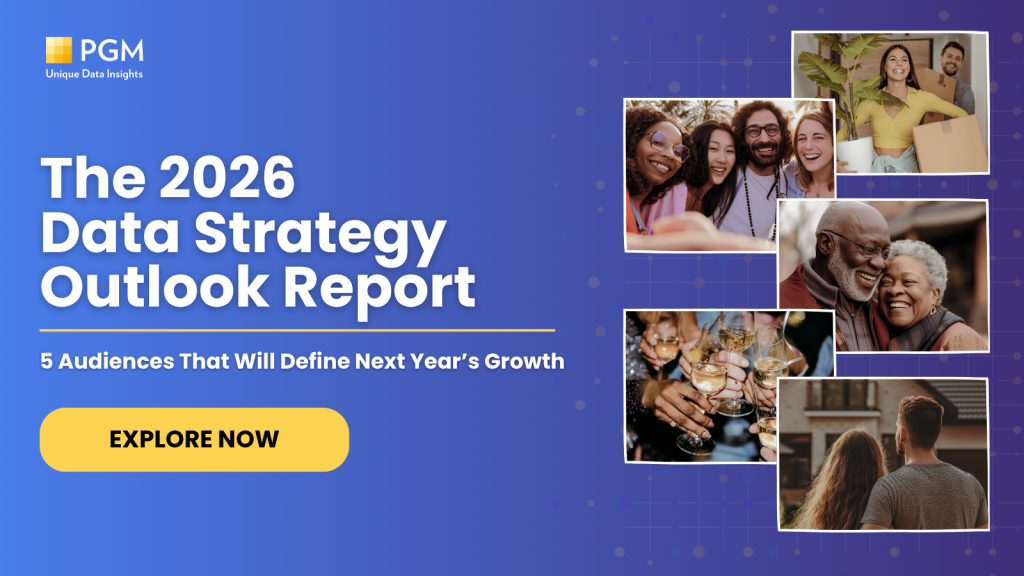Have you ever launched what you thought was a perfectly crafted marketing campaign? You worked so hard and yet, it missed the mark.
Odds are the problem wasn’t your creative. It just didn’t land in front of the right people.
The difference between silence and sales often comes down to how well you know your audience. And today, that means using consumer data to build smarter, more precise audience segments.
According to Aerospike, research shows that 77% of marketing ROI comes from segmented, targeted, and triggered campaigns. Additionally, about 80% of companies using segmentation report increased sales as a result.
Turns out, it’s not just what you say. It’s who you’re saying it to.
Let’s discover how to build better audiences for your next campaigns.
What Is Audience Segmentation—and Why Should You Care?
Audience segmentation is the strategic process of dividing a broad target market into smaller, more defined groups based on shared characteristics; such as demographics, behaviors, needs, interests, or buying patterns. This helps to deliver more relevant messaging, offers, and experiences that drive higher engagement and ROI.
Why Should You Care About Audience Segmentation?
When done right, segmentation drives real results because it:
- Improves Personalization: Understanding the differences between your audience segments will allow you to tailor your content, offers, and experiences. Instead of generic messaging that tries to speak to everyone (and ends up resonating with no one), segmentation helps you craft precise communications that connect on a personal level.
- Increases ROI: Segmentation helps
- Reduces Wasted Ad Spend: Without segmentation, you’re pretty much shouting into the void. Good segmentation means your ads reach people who are more likely to engage, convert, and stick around, saving you from paying for impressions or clicks from audiences who were never a good fit in the first place.
- Drives Better Creative and Messaging: Great creative work starts with clear audience insights. When your creative teams know precisely who they’re talking to, they can develop visuals, language, and storytelling that really resonates. Ultimately, audience segmentation is the foundation for smarter, more efficient, and more impactful marketing.
For example:
Imagine you’re marketing a fitness app. Instead of blasting the same message to all potential users, you might segment your audience like this:
- New Year’s Resolutioners – People looking to start a fitness journey in January. They’re motivated but need beginner-friendly plans and lots of encouragement.
- Busy Professionals – People with little time who want quick, efficient workouts they can fit into their day. Messaging focuses on convenience and time savings.
- Weight Loss Seekers – Users focused specifically on losing weight. They’re interested in meal plans, calorie tracking, and progress monitoring.
- Fitness Enthusiasts – Already active individuals looking for advanced challenges, performance tracking, and community competitions.
By personalizing your messaging, creative, and offers to each of these segments, you’ll speak directly to what matters most to them and dramatically increase your chances of engagement and conversion.
How to Build your Audience?
Let’s talk about the different types of data that can build out your audience.
1. Demographic Data
Demographics are the perfect starting point for segmentation. They describe who your audience is in a factual sense.
- Age: A skincare brand might promote anti-aging products to people 40+, while marketing acne treatments to teens.
- Income: A luxury car maker targets high-income households, while an affordable commuter car brand focuses on middle-income earners.
- Education: An online learning platform might segment content differently for users with advanced degrees versus those seeking basic certifications.
- Household size: A grocery chain might send bulk purchase offers to large families, but single-serving meal deals to one-person households.
While demographic data is incredibly useful, it’s important to remember that it only scratches the surface of who your audience truly is. Two people of the same age and income might have completely different interests, values, and buying behaviors.
2. Behavioral Data
Behavioral marketing data shows what people do; revealing clues about their interests, intent, and loyalty.
- Website visits: A visitor who browses hiking boots might get follow-up emails featuring trail gear and outdoor content.
- Clicks on specific content: A news publisher can serve up more political news to readers clicking on political headlines, and lifestyle articles to others.
- Cart abandonment: An e-commerce site might send a discount code to users who left items in their cart without completing checkout.
- Repeat purchases: Loyal customers could be offered exclusive VIP rewards or sneak peeks at new products.
Behavioral data is especially powerful because it’s based on actions, not assumptions. It reflects real-time intent and engagement, allowing marketers to react dynamically and deliver timely, relevant experiences. Unlike static demographic info, behavioral signals evolve constantly, giving you the agility to adjust messaging and offers as user behavior changes. When you lean into this data, you’re no longer guessing what people want—you’re responding to what they’ve already told you with their clicks, views, and purchases.
3. Psychographic Data
Psychographic marketing data dives deeper into why people behave the way they do, based on personality traits and inner motivations.
- Values: A brand committed to sustainability may target consumers who care deeply about the environment and ethical sourcing.
- Attitudes: A wellness brand might segment between those who view fitness as a lifestyle versus those who see it as a chore.
- Lifestyle choices: A travel company could segment between luxury travelers seeking five-star resorts and adventure travelers wanting rugged experiences.
Psychographic data adds emotional depth to segmentation by revealing the beliefs, values, and motivations behind consumer choices. Understanding the “why” enables marketers to create authentic, resonant messages that build stronger relationships and lasting loyalty—turning marketing from transactional to transformational.
4. Lifestage Data
Lifestage data focuses on major life events or circumstances that shape a person’s needs and priorities.
- New parents: Diaper brands and baby gear companies target new parents with newborn essentials and parenting tips.
- Retirees: Financial services firms offer retirement planning and travel deals tailored to older adults.
- College students: Tech companies promote student discounts on laptops and software.
- Newlyweds: Furniture and home décor brands might promote wedding registry services or first-home furnishing packages.
Lifestage data is powerful because it reveals key moments when consumer needs and behaviors shift. By understanding where someone is in their life journey, brands can deliver timely, relevant solutions that build trust and deepen relationships.
5. Geographic Data
Geographic data tells you where your audience lives, helping personalize messaging to local context, culture, and climate.
- Country: A fast-food chain might adjust menus to reflect regional taste preferences or dietary restrictions.
- City: A concert promoter targets ads for events happening in specific metro areas.
- ZIP code: A home services company markets differently to homeowners in affluent neighborhoods than in rental-heavy areas.
- Urban vs. Rural: A gardening supply store might promote balcony gardening solutions in urban areas, but large-scale landscaping tools in rural regions.
Geographic data adds a crucial layer of relevance by recognizing that location shapes people’s daily lives, preferences, and needs in unique ways. It enables marketers to personalize offers, timing, and messaging to local events, weather patterns, cultural norms, and economic conditions.
The real power of audience segmentation lies in combining demographic, behavioral, psychographic, lifestage, and geographic data to build rich, multi-dimensional profiles. This layered approach moves you beyond generic marketing, enabling hyper-relevant experiences that boost engagement, conversion, and long-term loyalty. In today’s competitive landscape, data-driven segmentation isn’t optional—it’s essential.
Let’s put these demographics together:
Imagine a premium outdoor gear company launching a new line of hiking backpacks. Instead of marketing broadly, they build a targeted audience segment by layering data across all five categories:
- Demographic: Target adults aged 25-45 with a moderate to high income (since the backpacks are premium-priced), who have at least some college education (likely to appreciate technical features).
- Behavioral: Focus on people who have recently visited hiking-related product pages on their website, clicked on content about trail gear, or added outdoor accessories to their cart but haven’t purchased yet.
- Psychographic: Prioritize individuals who value sustainability and an active lifestyle; those who care about eco-friendly products and enjoy spending time in nature for health and adventure.
- Lifestage: Segment for young professionals or newlyweds who are in a phase of establishing hobbies and investing in quality equipment, rather than retirees or families with children.
- Geographic: Focus on urban and suburban customers living near popular hiking destinations or in regions with accessible trails (e.g., Pacific Northwest, Colorado Rockies).
By combining these data points, the brand can craft highly relevant messaging, highlighting the backpacks’ eco-friendly materials, durable design, and features suited for weekend adventures, while serving ads during peak hiking season and offering promotions tailored to the lifestyle and location of their audience.
Conclusion
In today’s marketing landscape, simply having a good product isn’t enough. You need to understand who your audience is and how best to market to them.
When you understand demographic, behavioral, psychographic, lifestage, and geographic insights, you can deliver personalized messaging and create unique experiences for your audience that reflects the true complexity of their lives.
When you invest in the right tools and approach data with intention, your marketing becomes less of a guessing game and more about precision. That’s how you turn those casual browsers into loyal brand advocates.
Next time you are crafting your campaign, the key to making it perfect is by using consumer data to segment your audience.





